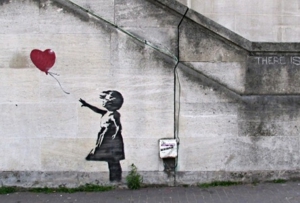 British street art icon Banksy is hardly a stranger to controversy, but now a Detroit art gallery may be under fire for hiding one of his murals.
British street art icon Banksy is hardly a stranger to controversy, but now a Detroit art gallery may be under fire for hiding one of his murals.Detroit’s 555 Nonprofit Gallery removed the Banksy mural from Detroit’s Packard Plant because gallery directors feared the work would be destroyed if left there, according to a report from the Detroit Free Press. The move was made without Banksy’s knowledge.
The mural, which depicts a boy with a bucket of red paint and the words “I remember when all this was trees” scrawled beside him, was on display for public viewing at 555 for 10 days, until phone calls and e-mails with messages threatening to destroy or deface the work led the gallery to hide the work as of Friday, May 28. The Free Press report said many people in the art world decried the gallery’s actions, with the argument that location is so important to street art that, without the original location, the work becomes meaningless.
What has ensued in Detroit, and in the art world at large, following the gallery’s dealing with the Banksy mural is an extensive and heated debate over street art and intellectual property. The presence of street art as a legitimized art form (thanks to artists like Banksy) has raised questions about ownership, and in this case, who would have jurisdiction over the fate of the Banksy mural. According to the Free Press, the lawyers interviewed agreed the Packard Plant’s owners have that jurisdiction because Banksy was trespassing on their property and abandoned his piece, although gallery directors say a Packard Plant foreman gave them permission to remove the mural.
It’s worth noting that the building Banksy painted the mural on is a work of art itself—the Packard Plant was designed by renowned German-American architect Albert Kahn in 1907 and apparently served as a hub of the underground techno scene in Detroit in the 1990s. Who knew?
No comments:
Post a Comment